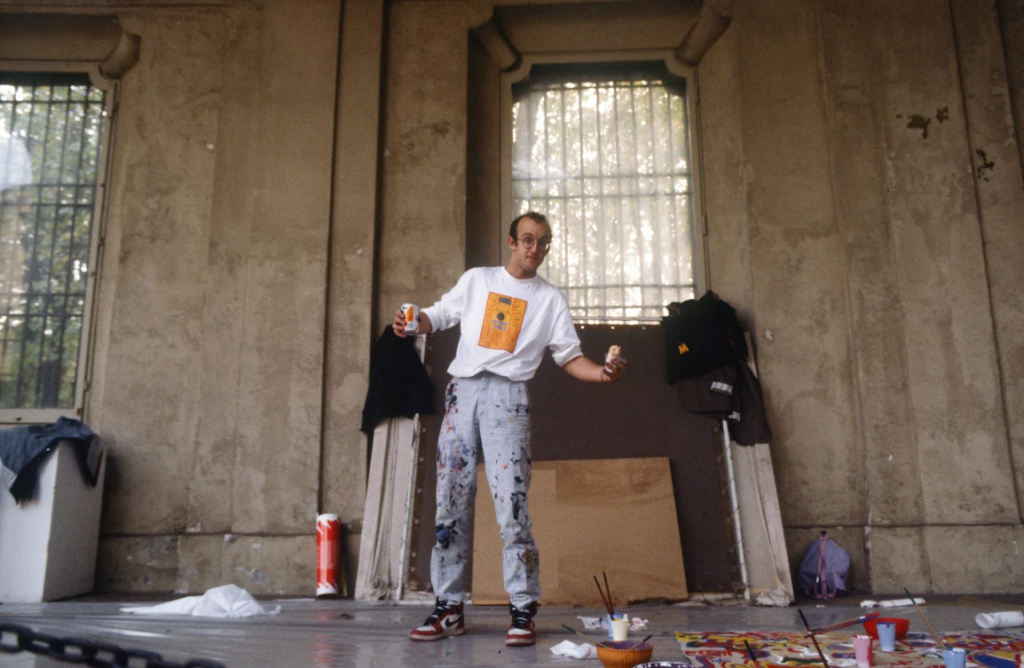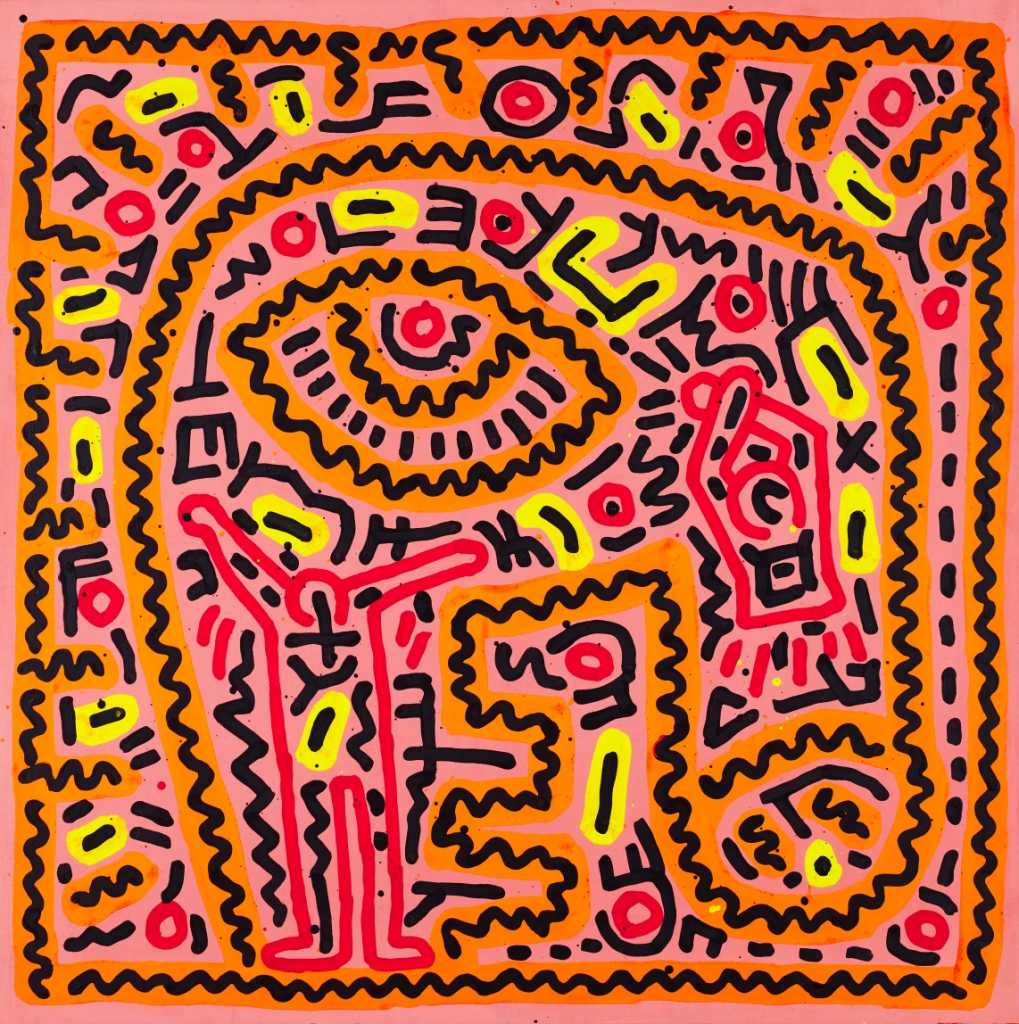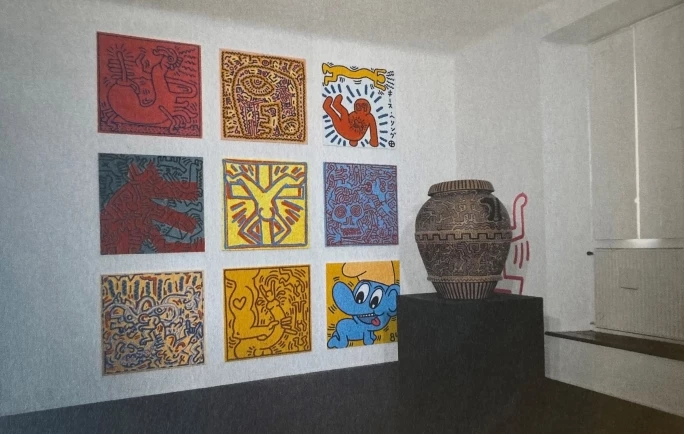“It was the idea of making the movements I was doing into a kind of choreography – a kind of dance. I was thinking that the very act of painting placed you in an exhilarated state.” – Keith Haring
In a heady mix of bright orange, pink, red, yellow and black, Untitled epitomises the frenetic energy and visual exuberance of Haring’s instantly recognisable style. Dancing figures, zig-zagging lines and dashes of paint bounce across the canvas to form a psychedelic pattern infused with uncommon vitality and optimism. The painting dates from Haring’s momentous exhibition at Galleria Salvatore Ala in June 1984 and was completed in the weeks prior during a whirlwind of making. Haring spent three weeks in Milan preparing for the exhibition, working in the gallery on via Mameli as well as studios and workshops throughout the city.

KEITH HARING, ROTONDA DELLA BESANA, MILAN, ITALY, 1987. PHOTOGRAPHY © MARIA MULAS. ALL RIGHTS RESERVED 2023 / BRIDGEMAN IMAGES.
By the opening, Haring had completed twenty paintings alongside terracotta vases, wooden works and plaster sculptures. A restless sense of discovery bounds through this collection, and as the Milanese critic Alessandra Galasso notes, the exhibition allowed Haring to “broaden his iconographical repertoire and to experiment with new techniques and materials” (Alessandra Galasso, Keith Haring a Milano, Milan 2005, p. 25). Untitled is a compelling example; painted with day-glo acrylic on muslin, it is one of first instances of these materials in Haring’s oeuvre. Executed at a seminal moment in his career, the painting is emblematic of the Haring’s artistic experimentation during those three weeks in Milan.

KEITH HARING, UNTITLED, 1984. ESTIMATE £1-1.5MILLION.
“The paintings, which made up the main body of the show, were my release. These paintings were some if my first with acrylic paint on stretched muslin. I chose to begin painting with acrylic because of the wide range of color I had been ignoring in my previous works on vinyl. I think I also just wanted to prove that I could paint, or do anything, if I wanted to.”
(Keith Haring quoted in: Alessandra Galasso, Keith Haring a Milano, Milan 2005, p. 11)
Haring arrived in Milan aged 26 and already an artistic phenomenon; he had visited the city the previous year, having been invited by Salvatore Ala for a group exhibition. By his solo show in June 1984, a constant stream of friends and visitors gravitated to the gallery to witness the artist at work, and accounts abound of Haring working non-stop for hours to deafening music, and painting with remarkable precision and speed. Salvatore Ala remembered Haring as “like a human dynamo, he painted without making any corrections, his gestures were fluid, and he never did any preparatory sketches, always preferring to work directly on the supports” (Salvatore Ala quoted in: ibid., p. 19).
Music and clubbing were formative to the Milan works and the influence especially visible in heady atmosphere of the present work. In an interview at the time Haring explained, “I work surrounded by music. My companion in New York is a disc jockey. Music in New York is part of daily life, it’s everywhere. And for me, it’s freedom: anyone can listen to it, you don’t have to pay for it, it makes you feel good, it inspires you, it uplifts you. For me this is art’s role” (Keith Haring quoted in: ibid., p. 26). In Milan, Haring frequented the infamous Milan nightclub Plastic, becoming good friends with the DJ Nicola Guiducci: “I stayed in the gallery late every night, painting until my hands hurt from holding the brush, and then I went to Plastic to unwind. Plastic is my favourite club in Europe, Nicola plays music that made me feel like I was in New York” (Keith Haring quoted in: Ibid., p. 29). For Haring, music and dance were a celebration of interconnectedness and the human spirit, a symbol of life and coexistence. With its clash of neon tones and kinetic mark-making, the present work mirrors the euphoria and dizzying energy of nightclubs.

KEITH HARING’S UNTITLED EXHIBITED AT GALLERIA SALVATORE ALA IN 1984. ARTWORK © THE KEITH HARING FOUNDATION.
The exhibition at Galleria Salvatore Ala and the intense interest it provoked is indicative of the widening influence of the New York art scene during the 1980s. With Andy Warhol, Jean-Michel Basquiat and Madonna amongst his friends, Haring was emblematic of a thriving cultural scene that was developing outside the gallery and museum world. Arriving in New York in 1978 to study at the School of Visual Arts, Haring was immediately inspired by the music and graffiti of the city. First appearing as chalk drawings on the subway, Haring created a singular graphic style based on the primacy of the line, that developed into the radiant colours of this painting.
By finding a direct means of expressing universal concepts of birth, death, love, sex and war, Haring created a lasting imagery that has been embraced around the world. Haring died tragically young, aged 31 from AIDS-related complications in February 1990. The legacy of the Milan exhibition came to the fore when the city held a major retrospective, titled ‘The Keith Haring Show’ held at Fondazione Triennale di Milano between 2005-2006. For Salvatore Ala, “the exhibition in via Mameli was one of the finest he [Haring] ever had in his career, Keith Haring’s gift to Milan.” (Salvatore Ala quoted in: ibid., p. 18)
“When you are visiting a country to work instead of as a tourist you experience it in a richer, more authentic way. This was particularly true in Milano. During the three weeks I spent working on this show I made many friends. In restaurants, paint shops, clubs, and of course the gallery. Even though I spoke very little Italian I found it easy to communicate. The combination of the people, the pasta, and easy-going, romantic lifestyle made it a perfect place to work.” (Keith Haring quoted in ibid., p. 11-12).
Source: Sotheby’s







